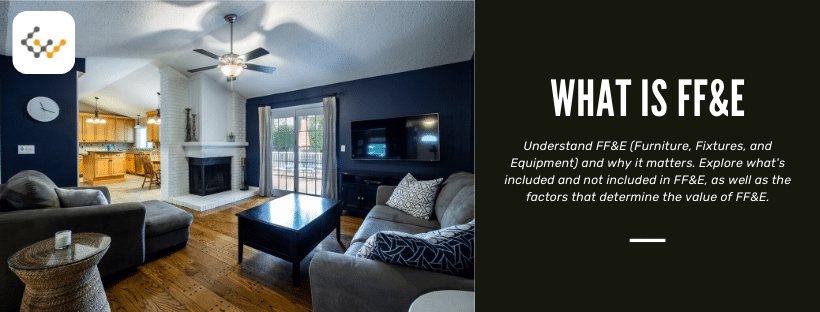What is FF&E and Why FF&E Matters in Real Estate?

Businesses may own many different types of property, with buildings, equipment, materials, and inventory being just a few examples. FF&E is one way of grouping assets that have value and last but aren’t part of a commercial real estate property.
What is FF&E?
Furniture, fixtures, and equipment (FF&E) refers to hard assets that last longer than one year but aren’t affixed to the building or property. Anything that could easily be removed today but will still be helpful next year likely falls under FF&E.
These are all assets that a business likely uses in its day-to-day operations and that have monetary value. They’re important components of the business’s fair value and would be taken into account during valuation, sale, or bankruptcy.
Most businesses have at least some FF&E assets, although the amount can vary depending on the industry. Some businesses might have a lot of furniture for an office or restaurant space or specialized equipment that would be costly to replace. Others might only need a couple of chairs, two desks, and a computer to operate. Each of these examples has at least some FF&E, though.
Answer a few questions and get custom mortgage quotes. We'll match you with offers from our network of 650+ lenders.
Why Does FF&E Matter in Real Estate?
With specific regard to commercial real estate, FF&E can impact both lease and finance negotiations:
- Lease: Whether the tenant or the landlord pays for FF&E can be a point of negotiation. This is especially true when negotiating the build-out of a space. The actual built-in features aren’t part of FF&E, but major equipment or appliances that are purchased during the build-out could be. Who’s responsible for these should be determined during negotiations, and so too should who owns them.
- Finance: The FF&E that a business owns is included in the business’s valuation, and it can be a major component of a business’s value in some industries. Thus, FF&E may impact sale-leaseback, credit tenant or similar agreements in which financing is based largely on the tenant.
How important FF&E is varies by industry. Hotels and furnished apartments often designate a portion of their budgets for FF&E. It’s certainly a consideration for restaurants, offices and many other businesses. It might not be a material factor when a contractor leases a storage facility, however.
Examples of Items Included in FF&E
As the acronym suggests, FF&E includes three broad categories that qualifying hard assets mostly fit into:
- Furniture: Office furniture is perhaps the most common example of an FF&E asset. This category can also include dining tables, booths, welcome desks, storage shelves, and almost any other furniture that’s not permanently affixed.
- Fixtures: Fixtures can include everything from lighting fixtures and window treatments to wall decor and indoor signs. Again, these are all items that aren’t permanently affixed to the property.
- Equipment: Most equipment that a business uses falls into FF&E, as it’s usually not a permanent installation in the building. This can include highly specialized equipment (e.g. coffee roaster, indoor merry-go-round), industry equipment (e,g, commercial refrigerator, vehicle lift), or common equipment (e.g. POS system, CCTV security system).
All of these have an expected useful lifespan of at least one year, and these aren’t a permanent installation on a property.
Items Not Included in FF&E
A number of items aren’t included in FF&E, even though they might account for a noteworthy portion of a budget or even valuation. Some examples of what’s not part of FF&E include:
- Installed Building Components: Walls, windows, doorways and flooring aren’t part of FF&E because they’re a permanent part of the building. Built-in bookcases and built-in cabinets aren’t FF&E because they’re permanent fixtures. Window blinds, door mats, and freestanding bookcases are still part of FF&E, though.
- Utility Systems: HVAC equipment, plumbing fixtures, and electrical systems are excluded from FF&E, even if a tenant pays for them. Freestanding space heaters and small air filters would be part of FF&E, but any building-wide air filtration system wouldn’t be.
- Inventory: Product inventory isn’t included in FF&E, even though it might be a significant portion of a business’s assets. Hopefully, any products will be sold within a year. They still aren’t part of FF&E even if they do sit on shelves longer, though.
- Supplies: Standard consumables like paper, pens, stamps and envelopes aren’t part of FF&E. Neither is sandpaper, any food ingredients, bags, or other supplies that a business might regularly go through. These things normally don’t last a full year.
What Factors Determine the Value of FF&E?
The value of a business’s FF&E is influenced by multiple details. Some factors affecting its value are:
- Original Cost: The original cost of an item sets the reference point from which its value is derived.
- Age and Condition: Age and condition impact the value of any used item.
- Depreciation Method: Lenders commonly follow any of the IRS-approved depreciation methods. FF&E might be depreciated according to a 5-year schedule, 50% in the first year, or via some other allowed method.
- Supply and Demand: For bankruptcy purposes, the supply and demand of an item primarily determines what it should be valued at by the court.
Many of these factors leave some room for discernment and potential disagreement. These factors provide a framework through which value can be discussed and determined.
Wrapping up
FF&E accounts for a significant portion of many businesses’ costs and assets. Make sure you understand what’s included in FF&E, so you can better negotiate commercial real estate leases.

